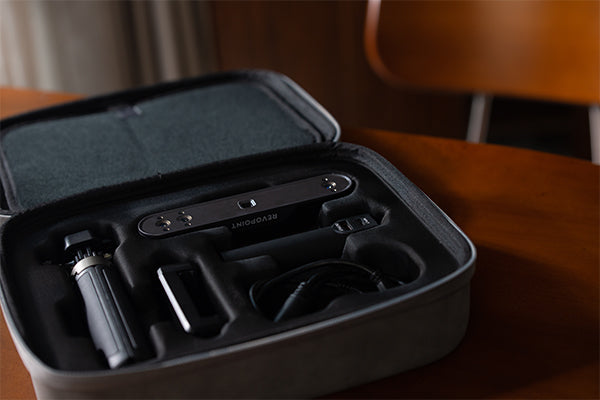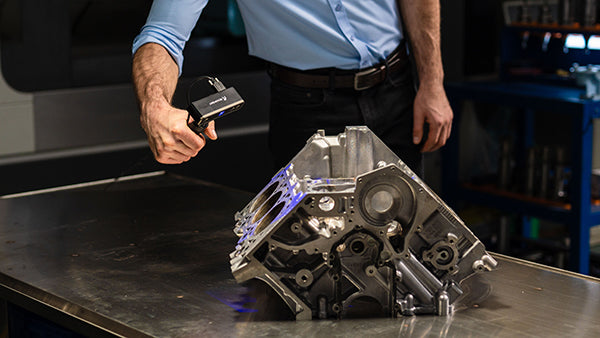Whipping out your phone and creating a 3D model anywhere, anytime sounds super helpful. Maybe even a game changer for making 3D scanning accessible to everyone. So, let’s get down to its brass tacks and see if your phone works as a 3D scanner and if it works well.
Yes, if you have an Android or iOS smartphone made in the last five years, you can use it as a 3D scanner. Basically, if your phone has a camera, it can work with a 3D scanning app. These apps use a sort of scanning called photogrammetry (a process of taking many photos of an object and stitching them together to make a 3D model) to capture the 3D models.
It’s worth noting that phones can be split into two tiers of 3D scanners as some newer phones also come with LiDAR (a process of measuring the time it takes for the light to return to the sensor), enhancing its ability to capture 3D models. At the moment, only Apple’s iPhone/iPad Pros from 2020 onwards come with LiDAR sensors, but this will probably change with augmented reality becoming more and more mainstream.
But before making your phone your primary 3D scanner, you should understand a few things.
What’s the Difference Between 3D Scanners and Smartphones?
Accuracy
In 3D scanning, accuracy means how close the 3D model is in size to the original scanned object. For most people buying 3D scanners, accuracy is essential, as they need their 3D model to match the measurements of the original as much as possible.
How Accurate are 3D Scanning Apps?
Developers of the various 3D scanning apps usually claim an accuracy between 0.5mm (with TrueDepth camera) to 1.5mm (no LiDAR) when scanning medium-sized objects. If scanning large spaces or objects, the accuracy is usually within 1~2% (with LiDAR) and within 5% (no LiDAR) of its actual size.
So 3D scanning with your phone using photogrammetry nor LiDAR-equipped smartphones is accurate enough for most professional applications. But if you don’t need your 3D model to be accurate, a 3D scanning app is generally acceptable for scanning most things. However, they will struggle with small items or objects with fine detail.
How About 3D Scanners?
3D scanners, since they usually use lasers rather than cameras to capture an object, are generally far more accurate than scanning apps, ranging from 0.001mm to 0.1mm accuracy, depending on how much the scanner costs and what kind of scanning technology it uses. Also, their accuracy stays more or less constant no matter the object’s size.
However, scanners tend to have less flexibility when scanning different-sized objects than smartphones. Because 3D scanners are usually optimized for small, medium, or large objects, if you want to scan a wide range of things, you’ll need more than one 3D scanner.
What About Color Scanning?
Smartphones certainly have the edge regarding color accuracy. As most 3D scanners only have a 2.1-megapixel camera compared to much more powerful multi-megapixel smartphone cameras. So 3D models made with a smartphone usually have vivid, high-resolution colors.
The reason why 3D scanners don’t have high-res cameras is that when color-scanning large objects like a car or a person. Thousands or tens of thousands of photos are captured alongside the point cloud data, which also can get pretty big. And if the scanner were using a high-megapixel camera, the file sizes would snowball rapidly, overwhelming just about any device’s RAM when trying to process the scan.
Any Other Key Differences?
Model Resolution
As 3D scanning apps have lower accuracy, the 3D model’s point clouds have a low resolution, with 1mm usually being the highest resolution available. Unlike 3D scanners, which typically have point cloud resolutions between 0.5mm to 0.01mm, so all the scan’s details are crisp.
Speed
Using photogrammetry to 3D scan something is slow, as you need a bunch of photos at various angles to capture an object. Whereas 3D scanners are much faster, the most powerful ones can capture an entire person in under 60 seconds. LiDAR is faster than photogrammetry and about on par with some 3D scanners in terms of capture speed.
Any Similarities?
Method of Scanning
With the right equipment, smartphones and some 3D scanners can be used as handheld or fixed scanners. Using either type as a fixed scanner increases scanning accuracy. But to do this, you’ll need a tripod and a turntable.
File Formats
Both 3D scanners and smartphones app can output models in the same formats, STL for 3D printing or PLY and OBY for 3D modeling software. Though file exporting in phone apps is often locked behind a paywall.
Which One is Right for Me?
Unlike many things in life, this one is an easy decision. If you don’t need accuracy or fine details, then using a phone as a 3D scanner is fine. But if you require accuracy, then a proper 3D scanner is the only choice.



Leave a comment
This site is protected by hCaptcha and the hCaptcha Privacy Policy and Terms of Service apply.